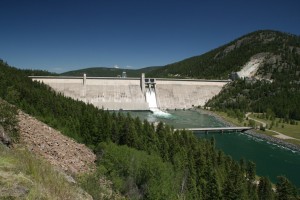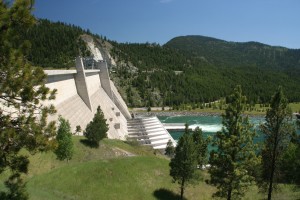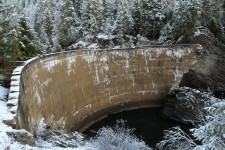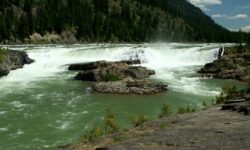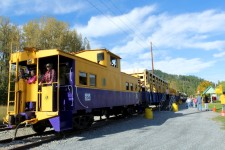Forty years after being completed (1972), Libby Dam is still fulfilling its mission of flood control on the Kootenai River. The Kootenai River is the third largest tributary of the Columbia River and over 8,900 square miles drain into Lake Koocanusa. With June precipitation being more than 300 percent of normal, the dam has helped minimize the flooding in Bonners Ferry but cannot eliminate it all.
The record levels of rainfall prompted the U.S. Army Corps of Engineers to temporarily raise the maximum elevation of full pool by one foot and then another foot, and luckily the peak level did not exceed the first additional foot. One foot may not seem like much, but considering Lake Koocanusa is 90 miles long, the gallons add up quickly. At normal full pool elevation of 2459 feet (total depth of 370 feet), Lake Koocanusa holds 5,809,000 acrefeet of water (an acrefoot of water covers 1 acre to the depth of 1 foot and equals 325,804 gallons)–that is approximately 1.89 trillion gallons. Adding one foot to the 46,500 acres that full pool covers means an additional 15 billion gallons of storage space.
Normally water only exits the reservoir through the generators so electricity can be generated. However, in emergency situations, such as this year, water is released through two spillways and three sluiceways because more water is entering the reservoir than can be passed through the generators without exceeding full pool.
The spillways release water from the top of the reservoir and look like waterfalls flowing over the front of the dam. The sluiceways release water from the bottom of the reservoir. The spillways are 48 feet wide and 56 feet high and at full capacity water flows through at 1.2 million gallons per second–eight times greater than Niagara Falls which has a normal flow of 150,000 gallons per second. A stilling basin below the spillways and sluiceways helps slow the water’s velocity to prevent downstream erosion.
In addition to spillways and sluiceways, Libby Dam was constructed with other emergency situations in mind. Although uncommon in our area, earthquakes can occur and the Libby Dam is built to withstand an earthquake up to 6.5 on the Richter scale. If structural damage does occur, the entire dam will not fail. Libby Dam is composed of 47 individual dams (or monolith sections) which act independently to hold back the water in the reservoir. The vertical lines on the front of the dam indicate the separate monoliths. If one monolith section fails, the adjacent sections are constructed to maintain their strength.
The sheer amount of concrete in Libby Dam holds back the water in Lake Koocanusa, not the shape of the dam. Over 7.6 millions tons of concrete were used in the construction of Libby Dam. Some dams are curved like Hungry Horse Dam near Kalispell, but Libby Dam is straight across the valley. In a cross section, Libby Dam is shaped like a right triangle with the base being 310 feet wide and the crest being 54 feet wide. At 422 feet tall and more than half-a-mile long, there is a lot more to Libby Dam than meets the eye.

